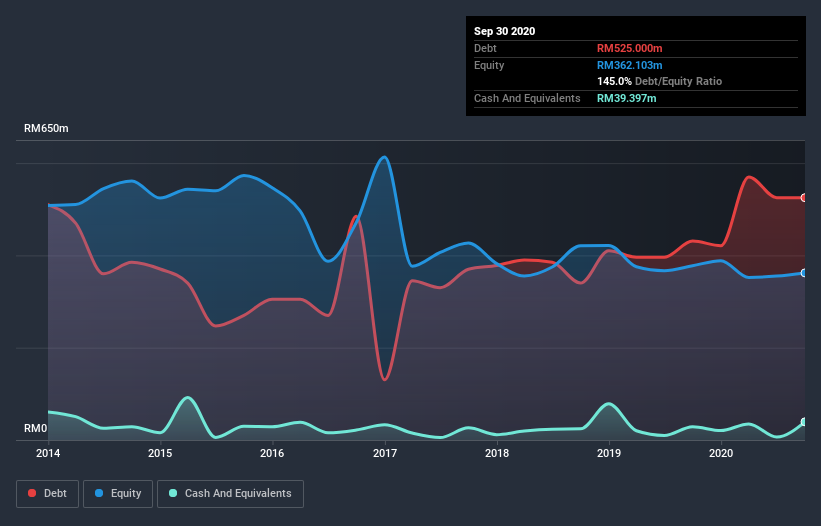These 4 Measures Indicate That British American Tobacco (Malaysia) Berhad (KLSE:BAT) Is Using Debt Reasonably Well

The external fund manager backed by Berkshire Hathaway's Charlie Munger, Li Lu, makes no bones about it when he says 'The biggest investment risk is not the volatility of prices, but whether you will suffer a permanent loss of capital.' So it seems the smart money knows that debt - which is usually involved in bankruptcies - is a very important factor, when you assess how risky a company is. We can see that British American Tobacco (Malaysia) Berhad (KLSE:BAT) does use debt in its business. But the real question is whether this debt is making the company risky.
Why Does Debt Bring Risk?
Debt and other liabilities become risky for a business when it cannot easily fulfill those obligations, either with free cash flow or by raising capital at an attractive price. Ultimately, if the company can't fulfill its legal obligations to repay debt, shareholders could walk away with nothing. However, a more frequent (but still costly) occurrence is where a company must issue shares at bargain-basement prices, permanently diluting shareholders, just to shore up its balance sheet. By replacing dilution, though, debt can be an extremely good tool for businesses that need capital to invest in growth at high rates of return. When we think about a company's use of debt, we first look at cash and debt together.
See our latest analysis for British American Tobacco (Malaysia) Berhad
What Is British American Tobacco (Malaysia) Berhad's Net Debt?
You can click the graphic below for the historical numbers, but it shows that as of September 2020 British American Tobacco (Malaysia) Berhad had RM525.0m of debt, an increase on RM431.0m, over one year. On the flip side, it has RM39.4m in cash leading to net debt of about RM485.6m.

How Strong Is British American Tobacco (Malaysia) Berhad's Balance Sheet?
Zooming in on the latest balance sheet data, we can see that British American Tobacco (Malaysia) Berhad had liabilities of RM751.6m due within 12 months and liabilities of RM18.8m due beyond that. On the other hand, it had cash of RM39.4m and RM378.3m worth of receivables due within a year. So it has liabilities totalling RM352.8m more than its cash and near-term receivables, combined.
Of course, British American Tobacco (Malaysia) Berhad has a market capitalization of RM4.04b, so these liabilities are probably manageable. But there are sufficient liabilities that we would certainly recommend shareholders continue to monitor the balance sheet, going forward.
In order to size up a company's debt relative to its earnings, we calculate its net debt divided by its earnings before interest, tax, depreciation, and amortization (EBITDA) and its earnings before interest and tax (EBIT) divided by its interest expense (its interest cover). The advantage of this approach is that we take into account both the absolute quantum of debt (with net debt to EBITDA) and the actual interest expenses associated with that debt (with its interest cover ratio).
British American Tobacco (Malaysia) Berhad has a low net debt to EBITDA ratio of only 1.3. And its EBIT easily covers its interest expense, being 23.1 times the size. So you could argue it is no more threatened by its debt than an elephant is by a mouse. In fact British American Tobacco (Malaysia) Berhad's saving grace is its low debt levels, because its EBIT has tanked 24% in the last twelve months. When it comes to paying off debt, falling earnings are no more useful than sugary sodas are for your health. When analysing debt levels, the balance sheet is the obvious place to start. But ultimately the future profitability of the business will decide if British American Tobacco (Malaysia) Berhad can strengthen its balance sheet over time. So if you want to see what the professionals think, you might find this free report on analyst profit forecasts to be interesting.
Finally, a business needs free cash flow to pay off debt; accounting profits just don't cut it. So the logical step is to look at the proportion of that EBIT that is matched by actual free cash flow. Over the most recent three years, British American Tobacco (Malaysia) Berhad recorded free cash flow worth 71% of its EBIT, which is around normal, given free cash flow excludes interest and tax. This cold hard cash means it can reduce its debt when it wants to.
Our View
British American Tobacco (Malaysia) Berhad's EBIT growth rate was a real negative on this analysis, although the other factors we considered were considerably better. In particular, we are dazzled with its interest cover. Considering this range of data points, we think British American Tobacco (Malaysia) Berhad is in a good position to manage its debt levels. Having said that, the load is sufficiently heavy that we would recommend any shareholders keep a close eye on it. There's no doubt that we learn most about debt from the balance sheet. But ultimately, every company can contain risks that exist outside of the balance sheet. Consider for instance, the ever-present spectre of investment risk. We've identified 3 warning signs with British American Tobacco (Malaysia) Berhad (at least 1 which is a bit concerning) , and understanding them should be part of your investment process.
Of course, if you're the type of investor who prefers buying stocks without the burden of debt, then don't hesitate to discover our exclusive list of net cash growth stocks, today.
If you’re looking to trade British American Tobacco (Malaysia) Berhad, open an account with the lowest-cost* platform trusted by professionals, Interactive Brokers. Their clients from over 200 countries and territories trade stocks, options, futures, forex, bonds and funds worldwide from a single integrated account. Promoted
Valuation is complex, but we're here to simplify it.
Discover if British American Tobacco (Malaysia) Berhad might be undervalued or overvalued with our detailed analysis, featuring fair value estimates, potential risks, dividends, insider trades, and its financial condition.
Access Free AnalysisThis article by Simply Wall St is general in nature. It does not constitute a recommendation to buy or sell any stock, and does not take account of your objectives, or your financial situation. We aim to bring you long-term focused analysis driven by fundamental data. Note that our analysis may not factor in the latest price-sensitive company announcements or qualitative material. Simply Wall St has no position in any stocks mentioned.
*Interactive Brokers Rated Lowest Cost Broker by StockBrokers.com Annual Online Review 2020
Have feedback on this article? Concerned about the content? Get in touch with us directly. Alternatively, email editorial-team (at) simplywallst.com.
About KLSE:BAT
British American Tobacco (Malaysia) Berhad
Manufactures, imports, markets, and sells cigarettes, pipe tobaccos, cigars, devices, and other tobacco and nicotine products primarily in Malaysia.
Fair value with mediocre balance sheet.

